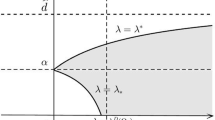Abstract
The existence of a stable positive equilibrium density for a community of k interacting structured species is studied as a bifurcation problem. Under the assumption that a subcommunity of k−1 species has a positive equilibrium and under only very mild restrictions on the density dependent vital growth rates, it is shown that a global continuum of equilibria for the full community bifurcates from the subcommunity equilibrium at a unique critical value of a certain inherent birth modulus for the kth species. Local stability is shown to depend upon the direction of bifurcation. The direction of bifurcation is studied in more detail for the case when vital per unity birth and death rates depend on population density through positive linear functionals of density and for the important case of two interacting species. Some examples involving competition, predation and epidemics are given.
Similar content being viewed by others
References
Butler, G. J., Hsu, S. B., Waltman, P.: A mathematical model of the chemostat with periodic washout rate. SIAM J. Appl. Math. 45, 435–449 (1985)
Cushing, J. M.: Equilibria in structured populations. J. Math. Biol. 23, 15–40 (1985)
Cushing, J. M.: Existence and stability of equilibria in age-structured population dynamics. J. Math. Biol. 20, 259–276 (1984)
Cushing, J. M.: Global branches of equilibrium solutions of the McKendrick equations for age-structured population growth. Comput. Math. Appl. 11, 175–188 (1985)
Cushing, J. M.: Bifurcation of time periodic solutions of the McKendrick equations with applications to population dynamics. Comput. Math. Appl. 9, 3 459–478 (1983)
Cushing, J. M.: Volterra integrodifferential equations in population dynamics. Mathematics of Biology, pp. 81–148. Centra Internazionale Matematics Estivo, Napoli (1979)
Cushing, J. M.: Periodic Kolmogorov systems. SIAM J. Math. Anal. 13, 827–881 (1982)
Cushing, J. M.: Periodic two-predator, one-prey interactions and the time sharing of a resource niche. SIAM J. Appl. Math. 44, 392–410 (1984)
Cushing J. M., Saleem, M.: A competition model with age structure. Mathematical Ecology. Lect. Notes Biomath. 54, 178–192. Berlin, Heidelberg, New York: Springer 1984
Gurtin, M. E., Levine, D. S.: On predator-prey interactions with predation dependent on age of prey. Math. Biosci. 47, 207–219 (1979)
Hastings, A.: Age dependent predation is not a simple process. I. Continuous time models. Theor. Popul. Biol. 23, 347–362 (1983)
Hoppensteadt, F.: Mathematical theories of populations: demographics, genetics and epidemics. Regional Conf. Series in Appl. Math., SIAM, Philadelphia 1975
Hoppensteadt, F.: An age dependent epidemic model. J. Franklin Inst. 297, 325–333 (1974)
May, R. M.: Stability and complexity in model ecosystems. Monographs in Population Biology 6, Princeton U. Press, Princeton, NJ 1974
Prüss, J.: On the qualitative behaviour of populations with age-specific interactions. Comput. Math. Appl. 9, 327–339 (1983)
Prüss, J.: Stability analysis for equilibria in age-specific population dynamics. Nonlinear Anal. Theory Methods Appl. 7, 1292–1313 (1983)
Smith, R. H., Mead, R.: Age structure and stability in models of predator-prey systems. Theor. Popul. Biol. 6, 308–322 (1974)
Waltman, P.: Deterministic threshold models in the theory of epidemics. Lect. Notes Biomath. 1. Berlin, Heidelberg, New York: Springer 1974
Webb, G. F.: Theory of nonlinear age-dependent population dynamics. New York: Dekker 1985
Author information
Authors and Affiliations
Rights and permissions
About this article
Cite this article
Cushing, J.M. Equilibria in systems of interacting structured populations. J. Math. Biology 24, 627–649 (1987). https://doi.org/10.1007/BF00275507
Received:
Revised:
Issue Date:
DOI: https://doi.org/10.1007/BF00275507




